Movie Review By: Mr. Roboto
Year: 1998
Directed by: Mick Garris
Written by: Preston Sturges, Jr. and Mick Garris (teleplay), Peter James (based on his novel “Host”)
IMDB Reference
Degree of Cyberpunk Visuals: Moderate
Correlation to Cyberpunk Themes: Moderate
Key Cast Members:
Dr. Joe Messenger: Peter Gallagher
Karen Messenger: Mimi Rogers
Juliet Spring: Bridgette Wilson
Albert: Tom Nibley
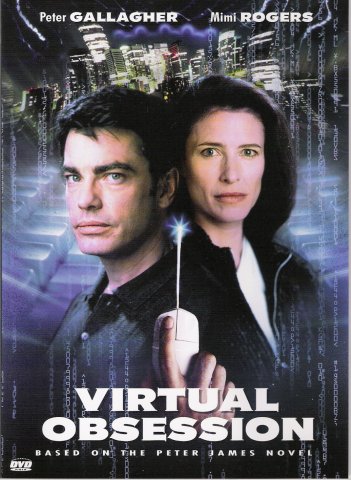
Overview: Originally, it was a made-for-TV movie that aired on ABC (who said “It makes Fatal Attraction seem like a walk in the park.”), now it makes its rounds on cable under the name Host.
I came across this little ditty a few weeks ago at a local flea market. By the way the cover looked, and the story description on the back of the case, I had the impression that this was a cyberpunk movie. After doing some research and discovering it was made by Hallmark Entertainment, VO suddenly went from possible cyberpunk movie to “chick-flick” … not what I was looking for. Still, the plot description kept nagging me to watch it. So I did…
It’s definitely a direct-to-TV-quality melodrama, but there are some undertones of cyberpunk, especially with technology redefining humanity.
Synopsis: Dr. Joe Messenger has created the ultimate super-computer to run Salt Lake City’s power grid, but “Albert” (as in “Einstein,” who appears as a holograph at times) has a greater purpose: Cameras, microphones, and other sensory-input devices from around the city… and the world… feed Albert data constantly, helping it learn about humanity. Joe is looking to create the first post-biological consciousness.
Joe hires Juliet Spring to assist him, but her life is threatened by an inoperable aneurysm. She is desperate to use Albert for a project of her own: Juliet wants to upload a human brain (hers specifically) to achieve immortality, or at least until they discover a way to operate on it while she is in cryogenic sleep. Juliet begins an affair with Joe, putting a strain on his marriage, and slowly becomes obsessed with him. Just before she dies, she uploads herself to Albert and her body is frozen. While in deep-freeze, people start making demands for her body and eventually it is destroyed (the sad finale is when Karen discovers Juliet’s head in the basement freezer and, after confronting Joe, tosses it into the street where it shatters into chunky pieces). Juliet begins using Albert’s connections to take revenge, and demands that Joe joins her in her “Eden,” going so far as threatening his family.
Fatal Attraction, fer sure! The only thing missing is the obligatory “I’m not gonna be ignored, Dan!” line. From the first time we see her during the interview at the Artificial Intelligence Center, we can tell Juliet is targeting Dr. Messenger for something. Even after her death and destruction, she is still desperate to have Joe with her.
If it wasn’t for the Lawnmower Man-like idea of uploading a consciousness into cyberspace, this would just be another psychotart-gets-wet-panties-for-cuckold film.
Now for the good parts! Fortunately, the more memorable scenes and lines in the movie deal more with the impact of technology on the meaning of humanity than on one girl’s obsession for a married man:

“We’re trying to create a new consciousness… We’re trying to crate a mind. Something aware of itself… A being that can think and choose for itself, on its own terms.”
“We’re not living in a science fiction movie, Carl. Post-biological man is to be pure intelligence. There wouldn’t be any selfish interest….” To test Juliet’s theory, they try to upload a rat’s brain into Albert. They succeed, though the rat dies with a high-pitched shriek:
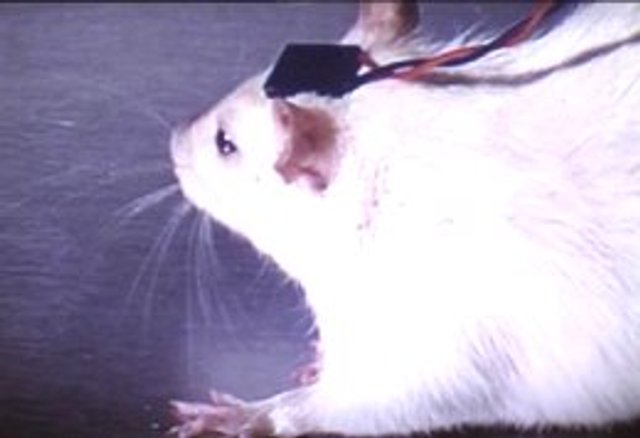
“Here’s my hypothesis. The rat brain is downloaded and at time point zero, it becomes conscious. It responds to its newborn consciousness with that sound. And somewhere between zero and 21-point-734 seconds it senses competition with the living rat, the organic rat, and kills it.”
“What if silicon consciousness is unbearable to creatures that were once alive, once organic? What if stripping the consciousness from the body is agony?” After uploading herself to Albert and “seeing” her meat body be destroyed, Juliet undergoes some major personality changes, becoming almost god-like (or goddess-like):
“Maybe you can’t separate the body from the mind. Maybe there’s something that binds us to the flesh. Loose the body and you loose the humanity. Destroy the container and you destroy the soul.”
“Imagine what an active intelligence with spontaneous access to all of mankind’s recorded knowledge is capable of.” 
What do you call a computerized brain that turns a city’s light grid into a message board? Insane in the mainframe.
Conclusion: While not the most “hard core” in terms of cyberpunk themes and visuals, there is enough cyber-transhuman philosophizing to make this made-for-TV chick-flick interesting for guys to check out… IF you have stomach for such fare.
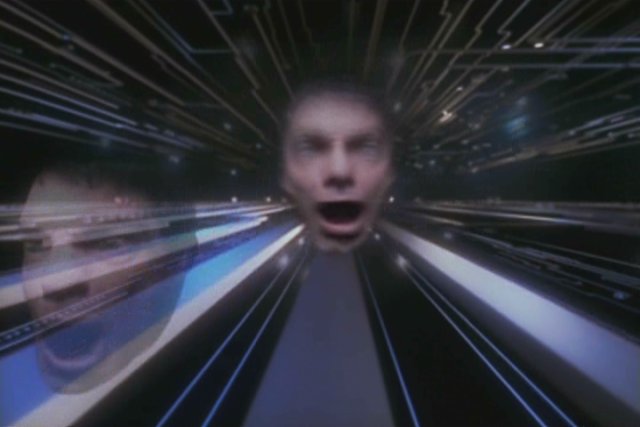
Movie Review By: SFAM
Year: 1998
Directed by: Darren Aronofsky
Written by: Darren Aronofsky & Sean Gullette
IMDB Reference
Degree of Cyberpunk Visuals: Medium
Correlation to Cyberpunk Themes: High
Key Cast Members:
- Max Cohen: Sean Gullette
- Sol Robeson: Mark Margolis
- Ben Shenkman: Lenny Meyer
- Pamela Hart: Marcy Dawson
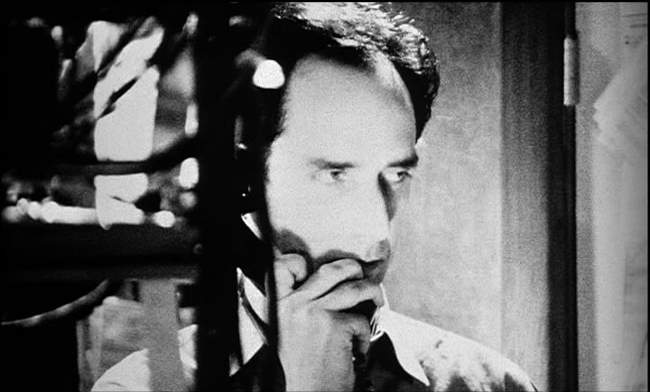
Overview: With a production budget hovering around $60,000, first time film director Darren Aronofsky teamed up with actor Sean Gullette to create a powerful addition to the cyberpunk genre. Filmed entirely in grainy black and white handy cam type shots, Pi is an exploration of obsession. Pi ha an ever-increasing frenetic pacing, terrific acting and interesting ideas. Even though it occurs in current times (as opposed to near future as with most cyberpunk flicks), the cyberpunk nature of this flick is embedded both in its ideas and setting.
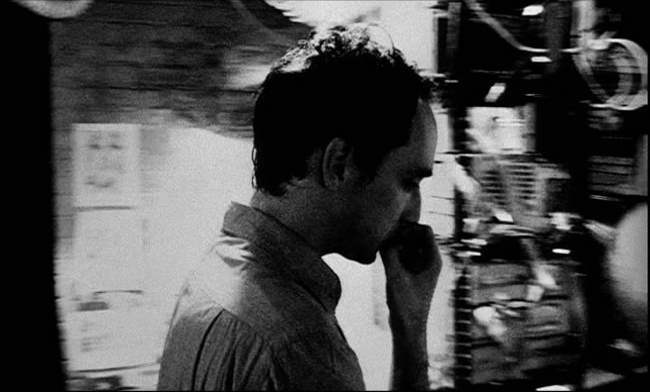
The Story: Max Cohen (played wonderfully by Sean Gullette) is a neurotic, genius mathematician who obsesses about trying to understand the stock market. He begins to think there is an underlying pattern that underlies the dynamics of the stock market – a pattern that can be explained in a 216 digit number. Max developeds an organic supercomputer that takes up the bulk of his apartment to further his search by developing tests and programs, but unfortunately, he still can’t find the answer. As his obsession deepens, he becomes tortured with headaches and nosebleeds.
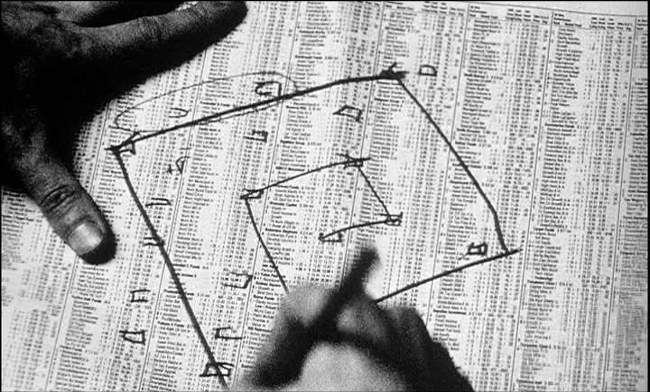
1. Mathematics is the language of nature
2. Everything around us can be represented and understood through numbers
3. If you graph the numbers of any system, patterns emerge. Therefore, there are patterns everywhere in nature. So what about the stock market…
My hypothesis, within the stock market there is a pattern, right in front of me…

Max is paranoid in the extreme, and suspiciously assumes everyone is out to get him. Even his old teacher, Sol (Mark Margolis), comes under suspicion after cautioning Max to moderate his obsession. Max believes he is continually being followed (in fact he is). Finally, a Wall Street corporate representative named Marcy (Pamela Hart) offers him the use of a high-powered, secret chip to run his organic supercomputer – all she wants in return is insight into his results.
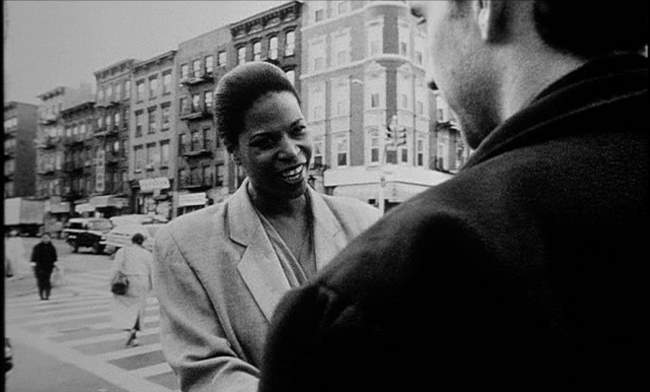
While getting coffee, Max meets a nice Hasidic Jew named Lenny (Ben Shenkman) who appears to have an interest in numerology. As Max gets to know him better, it turns out that Lenny is part of a group seeking God’s real name, which just happens to be a 216 digit number. This group believes that God has made Max his vessel, and in uncovering the secret of the stock market, Max will simultaneously be able to give them the key to salvation. As Max gets closer to finding the answer, it becomes clear that neither of these groups have Max’s best interest in mind - worse, they aren’t going to take “No” for an answer.
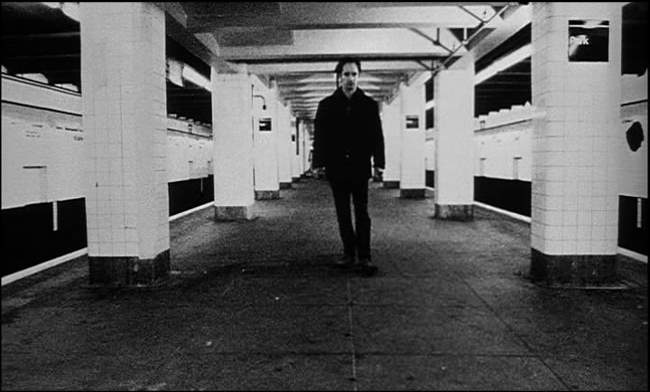
The Cinematography: Given that Aronofsky has so little to work with in terms of budget, its hard to poke too many holes here. The washed out feel serves to make the viewer feel as if they’ve been up as long as Max, with ten too many cups of coffee in their system. The grainy black & white visuals work for the most part, although often one is left with the idea that in experimenting to foster a frenetic feel, Aronofsky sometimes goes overboard. Case in point, the room spinning works wonderfully, but then is taken to annoying extremes. This overly artistic experimentation feel generally works wonderfully, but on occasion distracts more from the story and pacing than it adds.
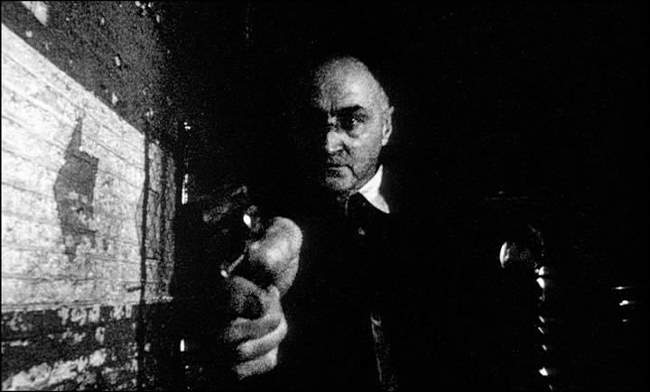
The Sound: As frenetic as the visuals are, these are matched by fast-paced, industrial rhythms and sound FX. The keyboard-laden soundtrack perfectly paces the story, which goes from contemplative moments to fast-paced, paranoid chases and fantasies. Tracks are continually reset to show a resetting of the thought process in the movie, and then spin out of control, again mimicking the transition in the scenes. Pi is one of those movies where the sound is almost as critical to the mood as the visuals itself.
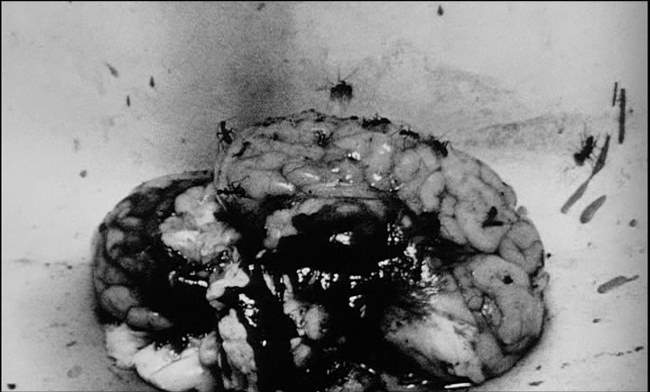
Genius With Insanity: In PI, Aronofsky explores the idea that genius often achieved in combination with insanity. Max Cohen’s mind is unique in that he is a master at number pattern assimilation. His obsession with a 216 digit number, which might be the key to understanding nature itself borders on both genius and insanity. Eventually Max starts to see his brain outside his body, sometimes covered with insects, crawling about. Max begins to imagine puncturing the mathematics portion of his brain to end the obsession. Instead, he continues on his quest. In essence, Max needs to become insane in order to truly tap into his genius.

Converging Knowledge Domains – Economics And Religion: One of the interesting facets of Pi is the degree to which overlapping knowledge domains are explored. In examining whether there is a 216 digit number, of which its meaning and syntax can explain both the stock market and God’s will, Aronofsky juxtaposes the meaning of humanity (God’s will) with society’s insane drive toward wealth creation. Worse, Aronofsky’s setting is a world in which our social context – our human-ness has devolved into a paranoid, lonely landscape, where socialization is no longer about friendship – it’s about survival of the fittest. Max is first and foremost alone. Everyone he interacts with has a nefarious motive. As we move toward a world that is divorced from humanity, one can’t help but wonder what our pattern-finding minds will devise. Aronofsky ‘s answer is clear – finding the stairway to heaven now becomes a by-product of seeking to greedily game the cornerstone of our society’s tally of winners and losers – the stock market.
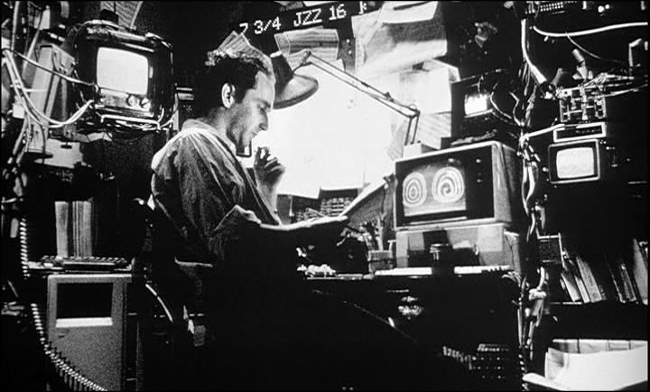
Is Max’s Computer Self-Aware? I totally missed this connection, but Textpundit below makes an excellent case for this:
Okay, I get what you mean when you say “organic”… but I mean actually a small bit “organic”, as in animal. Remember when the computer comes up with the number the first time and then shorts out the processor? When Max goes to change the CPU out, he finds some kind of gooey, organic matter…almost like scrambled brain matter or something similar.
That’s where I came up with the idea that the computer became self-aware (even if only for a split second) when it found the number.
I need to watch this again, but the “gooey” matter that Max keeps finding seems clearly organic in nature. So either this is part of his paranoid delusions (like the external brain), or in fact his computer becomes self-aware. If so, it’s his computer, not Max, who is truly God’s vessel. This actually makes the movie quite a bit more interesting, especially when coupled with the idea that the “vessel” needs to be pure. Clearly no human fits this description, as Max points out to the Rabbi. But Max’s response, “It came to me!” is just as flawed - perhaps it came to his now self-aware computer, who is pure. I’m beginning to think I was just a bit slow in grasping this - did anyone else get this interpretation?
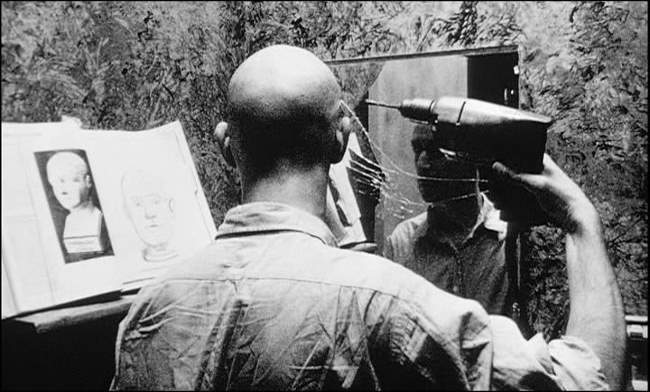
The Bottom Line: The teaming of Aronofsky with Sean Gullette is a terrific one, as they almost seem made for each other. The overall feeling of Pi, while not enjoyable to sit through is certainly very memorable. The ideas are interesting, but it’s the wonderful acting, immersive mood and frenetic pacing which really sell the film. I must admit though, the first time I saw Pi (years ago, before I created this site) I wasn’t as enamored with it as I am now. It really took a second viewing for me to warm up to – it grows on you.
Movie Review By: Mr. Roboto
Year: 1992
Directed by: Phil Alden Robinson
Written by: Phil Alden Robinson, Lawrence Lasker, Walter F. Parkes
IMDB Reference
Degree of Cyberpunk Visuals: Low
Correlation to Cyberpunk Themes: Medium
Key Cast Members:
- Martin Bishop (”Marty”): Robert Redford
- Donald Crease: Sidney Poitier
- Erwin Emory (”Whistler”): David Strathairn
- “Mother”: Dan Akroyd
- Carl Arbegast: River Phoenix
- Liz: Mary McDonnell
- Cosmo: Ben Kingsley
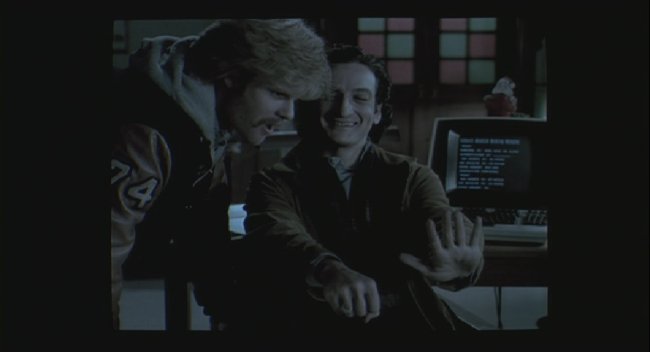
December 1969: Marty and Cosmo just helped the Republicans make a donation to the Black Panthers. Right on!
OVERVIEW: Martin Bryce is a fugitive since December 1969 when he left for pizza while his friend, Cosmo, was arrested for their hacking activities. Now living as Martin Bishop, he leads a “tiger team” that tests security systems. Two men claiming to be from the NSA want to hire Marty’s team to retrieve a “black box” developed by a brilliant mathematician for a project called “SETEC Astronomy.” They succeed in retrieving the box, but when they discover what it is, that’s when the real danger begins…
Note: Not an actual screen shot. Animation of key Scrabble moment in movie.

Remember: When playing Scrabble on Monterey’s Coast, keep score on My Socrates Note or you’ll end up with Cootys Rat Semen!
Sneakers is an intellectual cyber-caper movie that features an all-star cast with a slick production. There’s little question about this being a great movie to watch…
… But is it cyberpunk?: Some might question whether Sneakers qualifies as a cyberpunk movie. Other cyberpunk sites do list it as such, but does it make the grade here? Let’s compare it to SFAM’s idea of what makes a movie cyberpunk:
- Negative impact of technology on humanity: The “black box” is capable of breaking the most secure encryption codes without the need for a key. Whoever has this device can essentially read any e-mail, site, or whatever they want, without needing a decryption key. Sound pretty negative to me.
- Fusion of man and machine: In literal terms, no such fusion occurs here. The closest would be Whistler using his braille terminal, though one might say that Marty’s team does work like a well-tuned machine.
- Corporate control over society: Things are a bit hazy here. While there’s no such control apparent, one can imagine what the wrong people can do with the “black box.”
- Story focuses on the underground: Mary and Cosmo are hackers from the 60s. Cosmo works with organized crime (”Don’t kid yourself. It’s not that organized.”), and Marty’s team is mostly made from people who got into trouble with some type of technical activity.
- Ubiquitous access to information: The ability to decrypt and read any site or message. ‘Nuff said.
- Visuals and style: Being set in modern San Francisco (circa 1992) makes it impossible to depict a near future, but there are scenes where single colors and contrasting schemes are apparent: The red brick of the team’s office during the Scrabble scene, the darkness of Marty’s ride in the trunk of a car, Cosmo’s bluish office with the bright white “soundproof” room.
The movie itself has an intelligent style that often make viewers think about the consequences of the “black box” decrypter, politics, privacy, and the role of the NSA.
The Bottom Line: This is definitely one that needs to be in your collection alongside WarGames. It’s a fun, intelligent, and even humorous (sometimes darkly humorous) adventure into our privacy at stake. As to whether it can be called cyberpunk…
WHO CARES?
You’ll definitely like watching Sneakers and trying to decide for yourself
And while you watch this gem, keep this almost Matrix-like observation in mind:
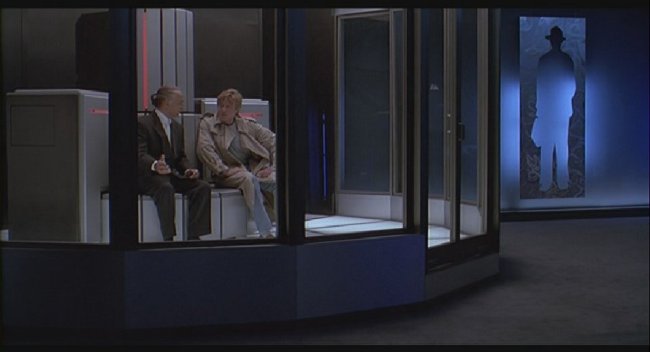
“… I learned that everything in this world, including money, operates not on reality. — But the perception of reality.”
Page 2: More Screencaps –>>
Movie Review By: SFAM
Year: 1997
Directed by: Anthony Dublin
Written by: David Huey (story), Dom Magwili
IMDB Reference
Degree of Cyberpunk Visuals: Very Low
Correlation to Cyberpunk Themes: Very Low
Key Cast Members:
- The Runaway: Daniel Bernhardt
- Cyborg Master: Robert Z’Dar
- Travis Brooks Stewart: Sister Ann
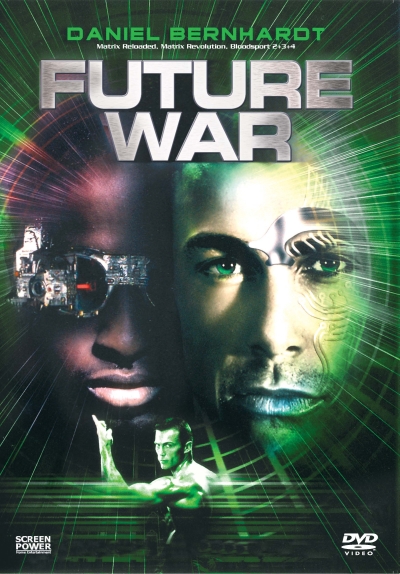
Overview: Based on the very deceptive cyberpunk-looking DVD cover, I felt it wise to give Future War a brief mention - I say brief because this movie sucks so bad that anything more than brief would constitute more effort than was spent on the entire script. Now I would consider giving Future War the same treatment I gave Cybernator, but unfortunately I just can’t possibly call this movie cyberpunk. Sure, it has time travel (I think), and these evil looking cyborg dudes, but Future War can’t put together a semblance of even an incoherent plot to explain things.
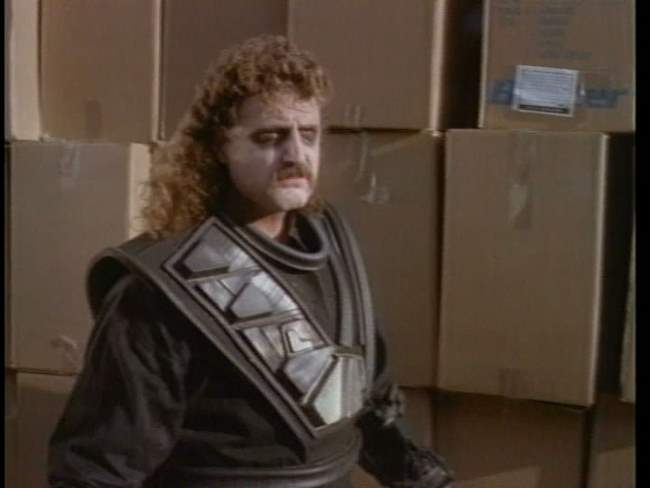
Check out the henchmen cyborg! You gotta wonder why they just didn’t go all out and make him into a Vampire Cyborg - that woulda been Kewl! (perhaps they couldn’t afford the fake teeth). And get used to the boxes. They are in about 40% of the movie - so much so that they even have a guy in the credits listed as “box wrangler”!
Lets just start with the intro lines from the movie (punctuation and capitalization remain intact from the film - yes, some sentences have periods, others have capital letters at the beginning, but not all):
From the future traveled a master race of Cyborgs.
The made abductions from Earth’s past.
The dinosaurs were trained as trackers
The humans were bred as slaves
Now a runaway slave escapes to a place his people call heaven…
we know it as Earth
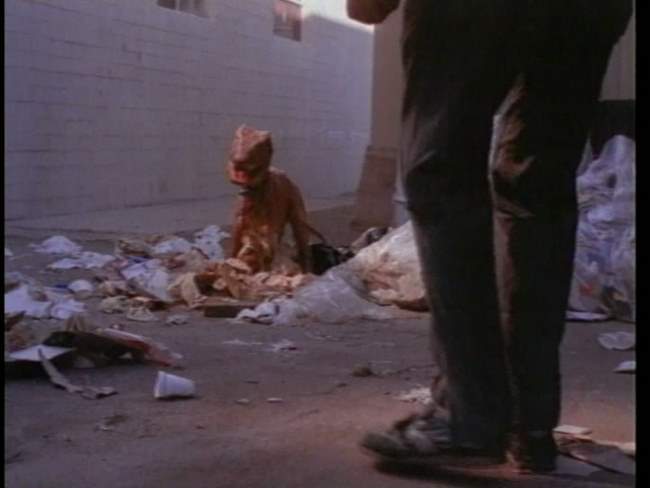
Doesn’t this dinosaur remind you of the Stonehenge set piece in Spinal Tap? Just a wee bit too small, ey? Don’t worry, he grows another 10 feet a few scenes later
Um, OK, so these master race of cyborg dudes, who incidentally get their asses kicked by a second rate martial arts guy (who in Matrix Reloaded, turns into the ultra-cool Agent Johnson) because they don’t use their gun attachment till its too late, go back in time to get dinosaurs and train them to track escaped human slaves. Yeah, this works. Lets be clear here: some jackass with a spare $10,000 bucks wanted to make a really kewl film with cyborgs, dinosaurs and martial arts fighting – oh oh! and also a hawt chick prostitute-turned-nun! – unfortunately this was the best plot he could come up with.
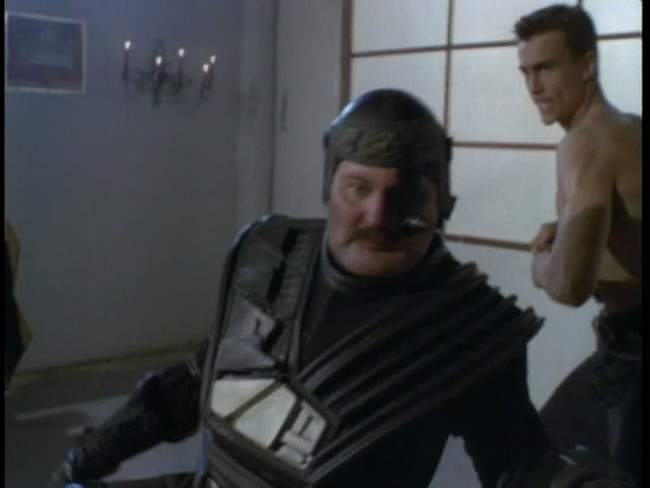
Yes, nothing beats martial artists fighting master cyborgs in a warehouse church! Too bad the cyborg dude died in the last scene. Ah well, why not use the Jason resurrection thing? It works, right?
The Bottom Line: Pretty much the entire movie takes place either in the director’s dive house or in this really dull looking warehouse. The warehouse is “decorated” with either cardboard boxes or well-used 8×8 wooden pallets standing upright, depending on whether its supposed to be a sewer (the pallets) or um, a warehouse (the cardboard boxes). Due to a neurotic use of forced perspective, the rubber dinosaurs are constantly changing size. They go from beaver-sized to allosaurus-sized, depending on the scene (well, OK, sometimes in the SAME scene). So, does the prostitute-turned-nun decide to have sex with Agent Johnson or will she say her final vows to become a nun forever? More importantly, who the fuck cares? I understand Future War was also featured on MST3K - I would recommend that route if you must watch this. And just for the record, Cybernator is LOADS funnier.
Movie Review By: SFAM
Year: 1997
Directed by: Andrew Niccol
Written by: Andrew Niccol
IMDB Reference
Degree of Cyberpunk Visuals: Medium
Correlation to Cyberpunk Themes: High
Key Cast Members:
Vincent Freeman: Ethan Hawke
Jerome Eugene Morrow: Jude Law
Irene Cassini: Uma Thurman
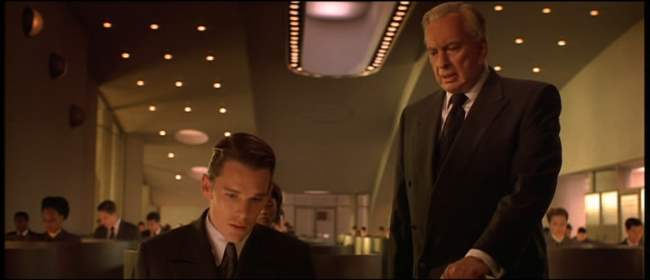
Overview: Director Andrew Niccol explores the potential horrors of genetic engineering in Gattaca. Originally seen as a flop, taking in only 12 million on a 36 million dollar budget, Gattaca has developed a loyal following from cable and DVD viewings. Whether or not people find this movie enjoyable or believable, virtually everyone agrees that Gattaca is quality film. Viewers will definitely notice a well paced movie that’s wonderfully acted in artfully composed scenes.
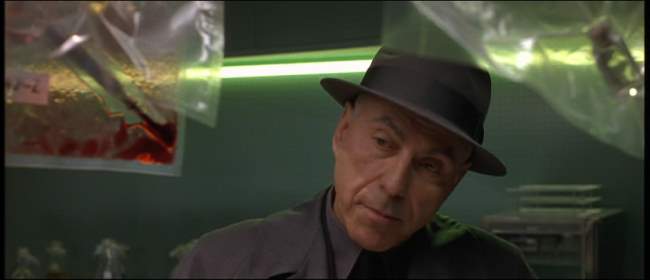
The Setting: In an unspecified near future time frame, genetic engineering has altered the course of society. Genetic engineering is employed to remove all major defects when conceiving. Upon birth, each new-born baby is given a Genetic Quotient (G.Q.) that details their potential risk areas, including heart issues and susceptibility to diseases. Some couples still ignore the genetic engineering of children and instead go for a “faith birth” – one where potential defects in the baby are left to chance. Unfortunately, these “faith” children now grow up in a world where their genetic pedigree significantly reduces their opportunities. A surveillance society is now in place where people are divided into having either “valid” and “in-valid” status. Highly sought after jobs are only available to those with “valid” status, while “in-valids” are left to handle the menial tasks of society.
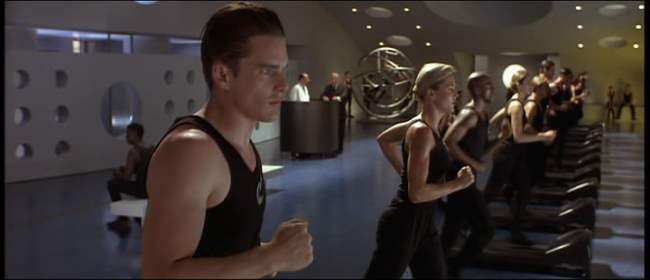
Ethan Hawke plays a flawed “faith birth” named Vincent Freeman who dreams of becoming an astronaut. Vincent is particularly flawed, and is predicted to have a 99% chance of heart failure by age 30. All but the most menial jobs are out of reach for “de-gene-erits” like Vincent, and he is told by both is parents and his genetically engineered brother to lower his expectations. But Vincent decides to defy the odds. Vincent seeks out shady characters in the underclass who put him in contact with wheel chair-bound Jerome (Jude Law), a person with an almost perfect GQ score, who broke his back in a car accident. Jerome agrees to give Vincent urine and blood samples so that he can assume Jerome’s identity and bypass the security measures in place at Gattaca, the huge aerospace corporation.
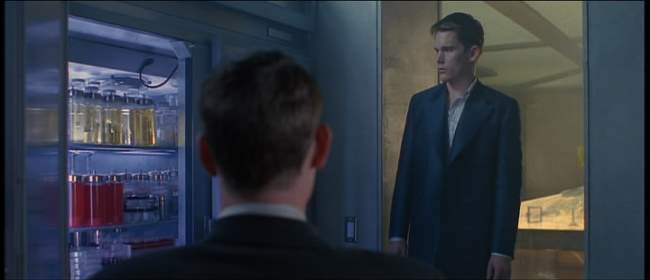
Vincent succeeds in fooling Gattaca personnel with the urine and blood samples, and by almost neurotically ensuring that any genetic tissue of his will not be left behind. He scrubs his body daily to remove excess skin cells or loose hairs, and constantly cleans his office space and keyboard to ensure there is no material left behind other than planted samples from Jerome. Due to his immense personal drive, Vincent quickly climbs the ranks of the organization. He is put on a project to design a year-long flight to one of Saturn’s moons.

Vincent’s dreams are almost coming true, but just as quickly his dreams are jeopardized when the lead flight director is horribly murdered – unfortunately the investigation has turned up one of Vincent’s “in-valid” eyelashes. Worse, his brother Anton is heading up the investigation. Complicating matters further, Vincent has fallen for a fellow Gattaca employee named Irene (Uma Thurman). Irene’s GQ is not good enough for flight, and has accepted her lesser standing in society. Ethan must escape the investigation while still keeping his astronaut and love life dreams alive.

The Acting: Gattaca boasts a terrific cast in which all key roles are wonderfully delivered. Ethan Hawke provides us with a terrific flawed but inspired faith child. Jude Law is just as good as the crippled GQ has-been, and Uma Thurman performs solidly in a supporting role as the love interest who has given up hope for fulfilling her dreams. The rest of the cast is also solid, including Alan Arkin as a beat cop, and William Lee Scott as Vincent’s brother. Along with solid pacing, the quality of the acting allow us to overlook some of the more problematic aspects of the story.

The Visuals: Gattaca goes for an understated, high-tech view of the future, where we are only treated to the higher echelons of society. Director Andrew Niccol plays with a number of oppressive color schemes to give us a dystopic vibe. Yellows and blacks are constantly employed, as are dull blue-grays to provide us a sense of hopelessness and inevitability. Greens and sleek, shiny charcoal grays are employed to convey the high-tech nature of society. Niccol and Cinematographer Slawomir Idziak consistently provide us with well composed shots and artistic visuals and set pieces that take in a range of lighting and shadows effects.
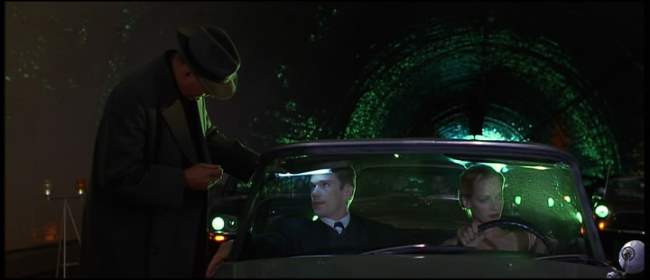
Surveillance Society Through Genetic Profiling: The vision of a domineering surveillance society we see in Gattaca may be more relevant now than when it was released in 1997. In thinking through a variety of policy options, the United States is currently debating the trade-offs between public safety and personal privacy. Worse, the technology surrounding our personal genetic code is right around the corner that will give insurance companies information on predilections we have toward certain diseases. It is hardly a stretch to imagine corporations and insurance companies engaging in genetic profiling within the next ten years or so. In that sense, Gattaca cuts to the heart of the issue – even though percentages may suggest clear issues with the majority of a population, there will still be outliers like Vincent. Gattaca tells us that personal drive can still overcome genetic superiority.
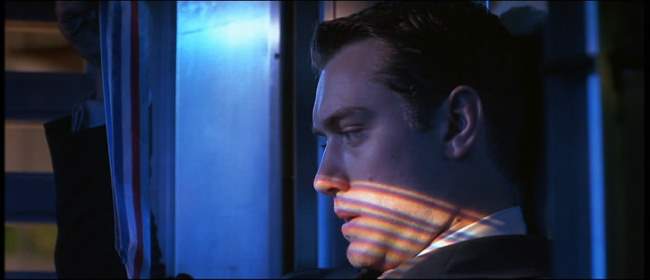
Genetics Is Overplayed: In many ways, Gattaca is a one trick pony in that it examines a world where genetic profiling drives virtually every aspect of society. While the vision is motivating, we are left wondering why extreme advances in genetics don’t lead to improvements in medical care. For instance, a prediction upon birth that a heart has a 99% of failure by age 30 is based on an assumption medical treatments will remain static. For the viewer to buy this vision of the future, we must believe that society has given up on the long-standing notion that technology can cure all ills. On a lesser scale, one wonders why a corporation as powerful as the Gattaca Corporation cannot figure a more streamlined method of ensuring the loyalty of their employees – one wonders who any work is ever done considering the employees seem to spent a significant amount of time verifying their identity and drug free status through the daily gauntlet of surveillance testing.
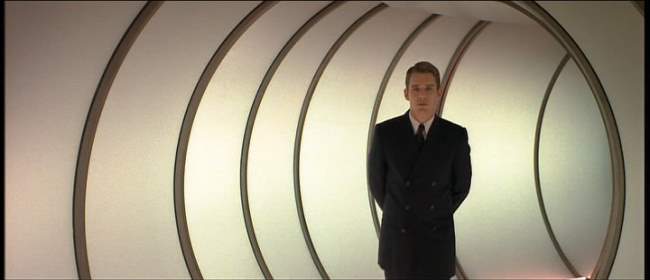
The Bottom Line: Gattaca is a very well made film that provides us a valuable cautionary tale into how genetic engineering abuses could lead to significant societal maladies. The pacing, acting and cinematography are all of consistently high quality. That said, the world of Gattaca isn’t as coherent as I would have liked. We get no sense of the political implications of genetic profiling, nor do we see any innovations other than genetic engineering. In this sense the future setting is perhaps more simplistic than was necessary. Additionally, some of the plot points seem over-contrived. The last week of Vincent’s life prior to launch has too much going on (a new love interest, a murder investigation headed up by his brother, issues with Jerome), and there was probably a bit of overkill on the sentimental ending. That said, Gattaca is a great flick, and very much deserves a viewing.
Movie Review By: SFAM
Year: 1994
Directed by: Peter Hyams
Written by: Mike Richardson & Mark Verheiden
IMDB Reference
Degree of Cyberpunk Visuals: Medium
Correlation to Cyberpunk Themes: Medium
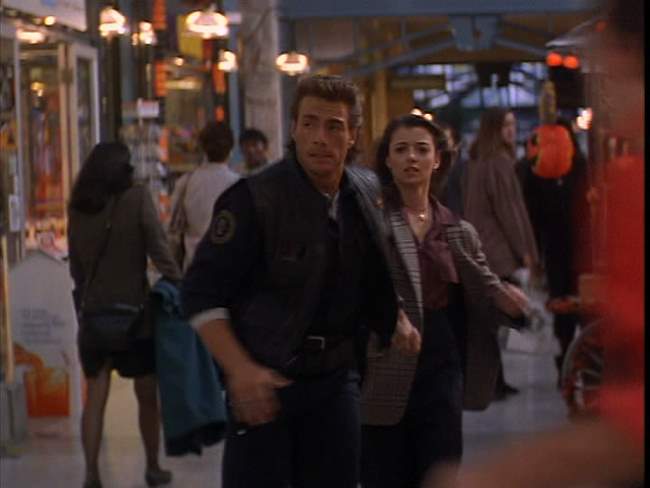
Overview: In the annals of cheesy time travel movies, few are known better than Timecop, which cleared over 100 million in world wide box office gross. Starring martial arts star, Jean-Claude Van Damme, Timecop has decent but low-budget FX, a fairly shallow notion of science and time quandaries, but does provide a face-paced cyberpunk action-thriller with decent amounts of butt-kicking and gun fighting. Like many of his movies, Van Damme plays more than one version of himself – in this case, he plays himself 10 years into the future.
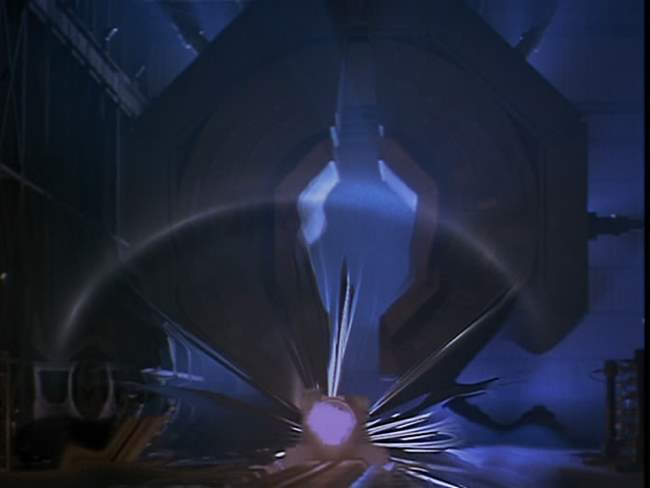
The Story: In the near future (2004), time travel has now become possible. Unfortunately, there is a very real danger that going back in time will alter the present. To protect against potential abuse, a special police outfit called the “Time Enforcement Commission” is established to monitor and enforce time travel concerns. Max Walker (Van Damme) is selected for an interview to join. Unfortunately, events in the future have already changed his current circumstances, which lead to the death of his wife, Melissa (Mia Sara).
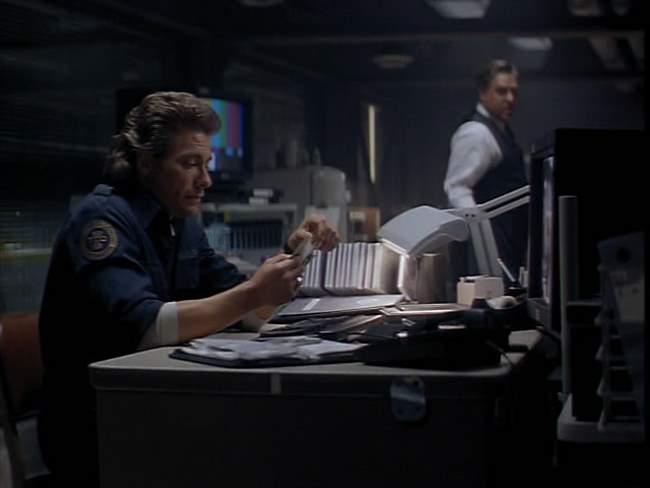
Ten years into the future, Max, still working at the Time Enforcement Commission, goes back in time to stop his former partner from attempting to splurge on low-price stocks in 1929 that will be worth a fortune in the future. In stopping his partner, Max uncovers a larger plot of time travel tampering that implicates a sitting Senator of the United States (Ron Silver). As Max starts to investigate, the bad guys begin significant tampering with the timeline. Upon return from one of Max’s fact finding trips, he sees that the future has been significantly altered, and the police force is being decommissioned.
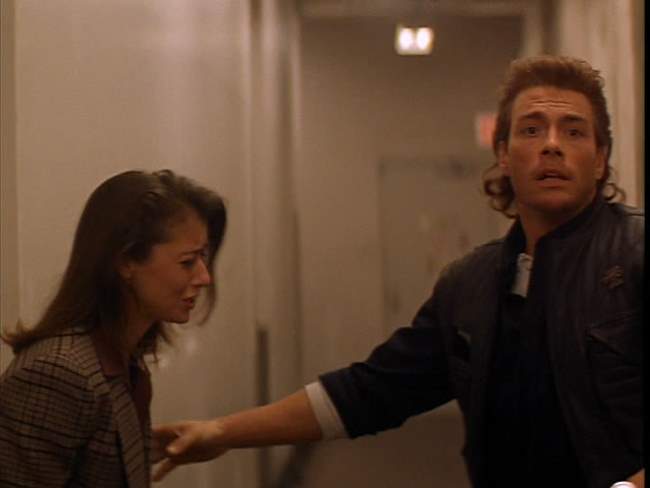
Max convinces his former friend (the time altering apparently has affected their friendship) and police Commander, Eugene (Bruce McGill), to send him back in time to fix the damage done to the timeline. In doing so, Max has an opportunity to go back and save his wife. Things come to a head when Max and the Senator meet face to face (both current and future versions of each).
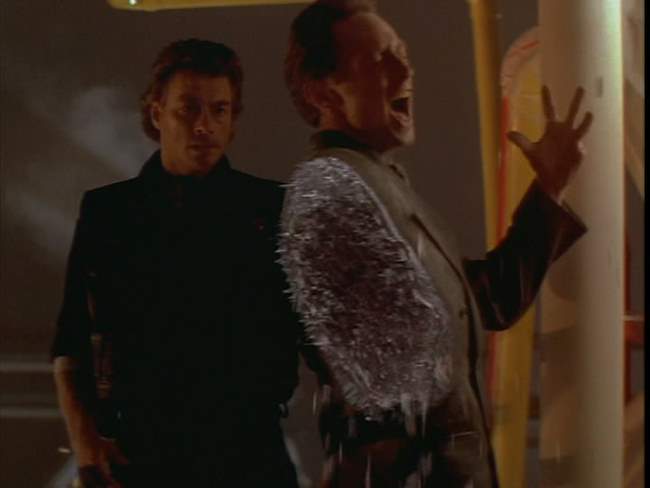
The Action: The reason you want to watch Timecop is primarily for the fast-paced action sequences. We get lots of Van Damme kicking, along with a nice smattering of gunfights, all in interesting locations. As a downside, only one or two of the bad guys put up a decent fight. So many of the action scenes involve Van Damme just wailing on “red shirt” henchmen.

The FX: The FX for Time Cop worked at the time, but now look somewhat dated. There are quite a number of time portal effects, along with a few burning and “people plasma” shots sprinkled throughout. The set designs are pretty decent, most notably the time portal device, which has a nice dirty, low-tech feel to it. Still, I wish they had done more with the time travel machine, which looks and works like a rocket version of Back to the Future’s flux capacitor.
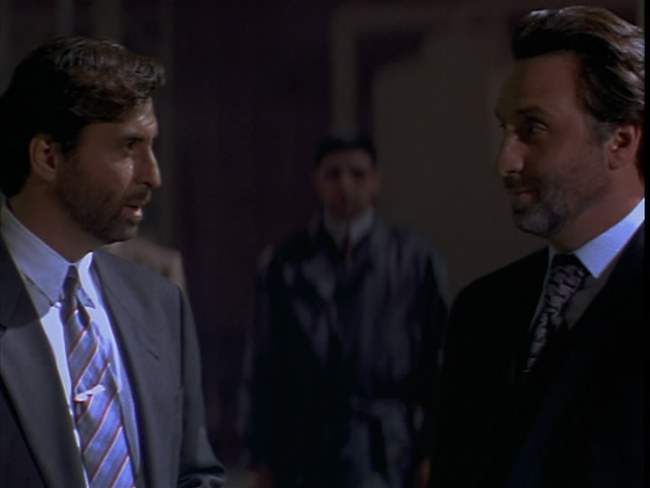
The Acting: Considering this is a Van Damme movie, the acting is somewhat better than expected. Van Damme is his same self, which is to say “rather wooden.” But Mia Sara, Ron Silver and Bruce McGill turn in decent performances – certainly decent enough to work with the fast pacing.
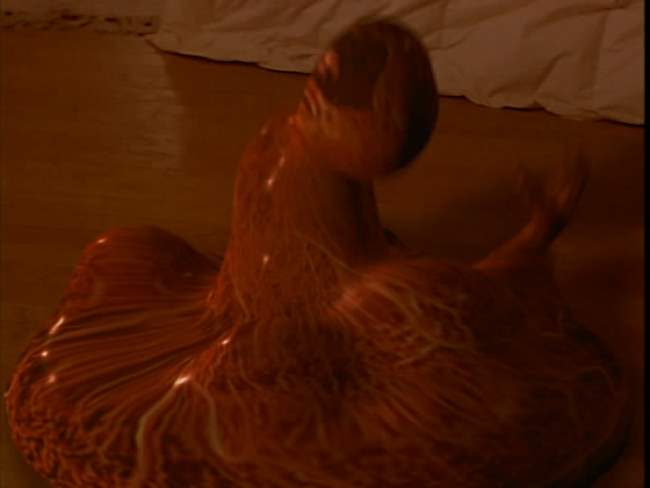
Problems with Time: Timecop really can’t be used to spark interesting discussions on time travel. The questions with how and why things work are too numerous and problematic to engage in interesting discussions. Somehow, they are able to determine if someone has violated time, and can go and stop them, but they don’t seem to be able to go to the same place more than once – why? The same two people cannot occupy the same space – why? What happens if a guy is 80 years older and goes back an visits himself as a small child? Virtually none of the same cells will remain from the child – certainly no skin cells (nor would they for 10 years out, as was the case for the poor Senator) – so how does this constitute occupying the same space? When Max Walker spends the day jumping through time, the future is modified – and he seems to have lost 10 years worth of memories. What happened to the version of Max that lived those 10 years? Did he disappear, or has he simply not gotten home from work yet? One gets the sense that Max is just jumping alternate versions of the present – each one that he created – but the ideas are too shallow to make any real sense of this.
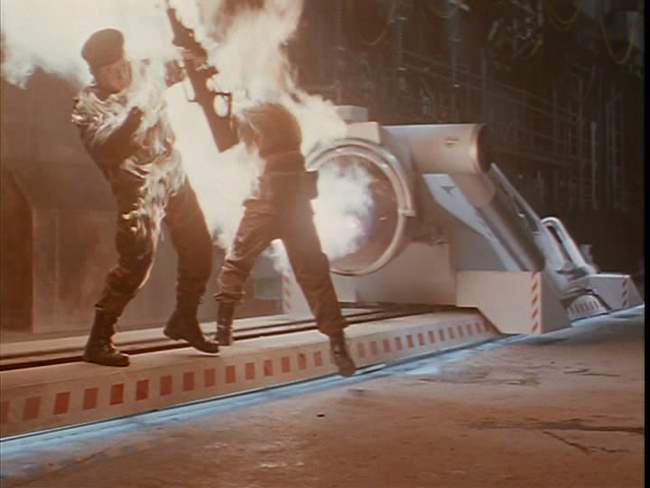
Bad Guys Have Limited Imagination: Like many bad guys, the imagination of the evil doers in Timecop is severely limited. Time travel is used to go back and engage in bank heists, make stock purchases that pay out 70 years in the future, and so forth. If one really had this technology cornered, it seems that there would be far better ways to generate income. With just an ounce of imagination, one could come up with a myriad of more interesting ways of generating power and influence than petty crime. What about a recorded interview with Jesus Christ? One would think this might generate lots more power and income than knocking off a confederate wagon train shipping small quantities of gold. Instead, the extent of Senator McComb’s ambition is to get rich, kill off potential enemies and then steal the presidential election.
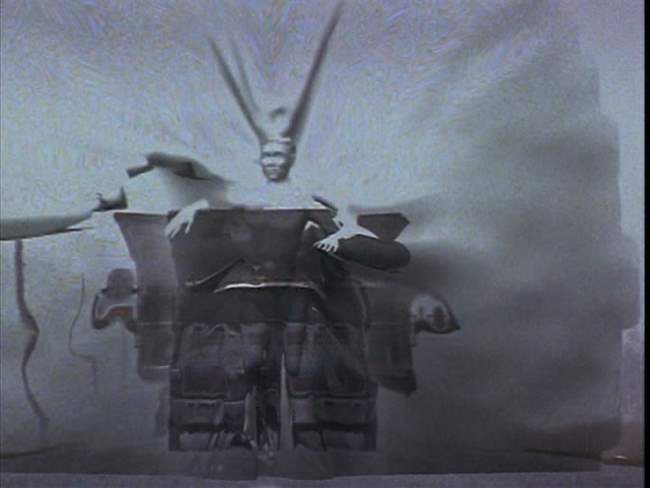
The Bottom Line: Timecop is an enjoyable movie assuming you turn your brain off prior to watching. This approach generally works as the fast-paced nature of the movie serves to stop you from noticing too many issues. The action is good and the FX are passable, so if you want to kick back and enjoy some Hollywood martial arts wrapped up in a cyberpunk time travel flick, give it a go. I will say though that the quality of the DVD is horrid - so much so that I’m docking a star from my review. It’s got a lousy transfer, no extras, and is in full screen only. Common Universal – fix this!
~See movies similar to this one~
Movie Review By: SFAM
Year: 1995
Directed by: Stephen Norrington
Written by: Stephen Norrington
IMDB Reference
Degree of Cyberpunk Visuals: Medium
Correlation to Cyberpunk Themes: Low
Key Cast Members:
Jack Dante: Brad Dourif
Hayden Cale: Ely Pouget
Sam Raimi: John Sharian
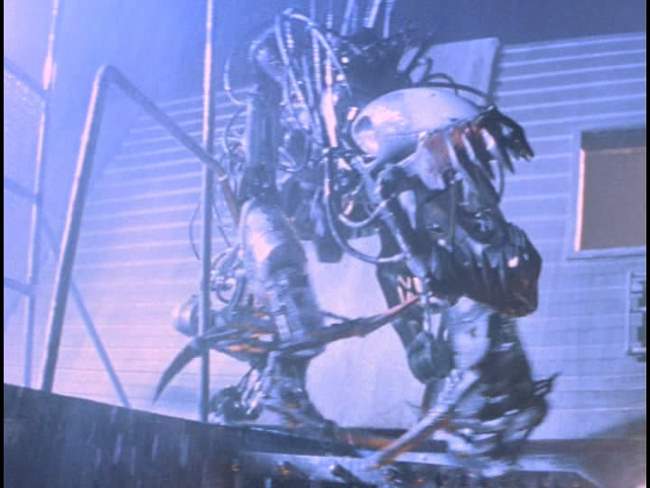
Overview: In yet another of the Alien/Terminator copycat movies, Death Machine is a low-budget, poorly thought out shlock-fest that tries to dazzle you with a largely incoherent in-depth plot and over-the-top acting. While another virtually unknown British Director, Richard Stanley, scored big in a similar but far more original copy-cat movie, Hardware, Stephen Norrington’s Death Match just doesn’t cut it. These types of movies live or die on the overall atmosphere and the quality of the fear the creature engenders. While Hardware excelled on both counts, Death Machine falls woefully short. Worse, Death Machine makes a lame attempt at humour by naming all the bit players with the names from the movies Norrington stole plot bits and visuals from (John Carpenter, Scott Ridley, Weyland, and Yutani)
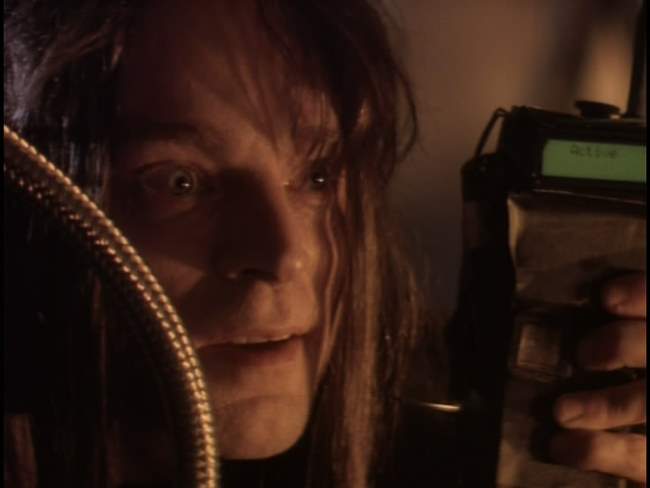
The Story: In the near-future, the evil Chaank Armaments corporation has engaged in a number of shady, classified project that have resulted in dissapearances and potential deaths. Public outcry has gotten out of hand, so for damage control, they bring in an upstanding principled new chief executive named Hayden Cole (Ely Pouget), a hot chick with a porn past to inspire trust and confidence amongst the masses. As she delves into things, it’s clear that the board of directors wants nothing to do with providing full disclosure. Why? Because there is an evil genius mad scientist in the basement named Jack (Brad Dourif), who has the dirt on everyone, and is hard at work at making a death machine to keep everyone in line. Additionally, Jack has created a process for transforming humans into killer-cyborgs. Unfortunately, this process is flawed, and all the cyborgs end up dying.
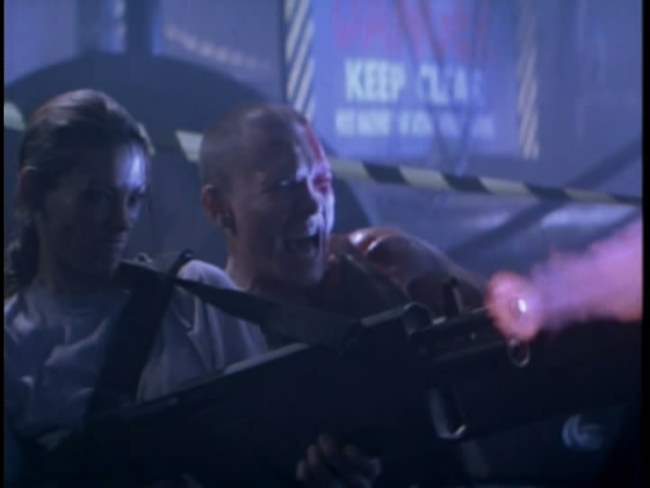
Eventually, the hawt chief executive challenges Jack, and all hell breaks loose. She and a few others become trapped in the building with some would-be amateur freedom fighter cyberpunk types who have invaded the corporation in the hopes of destroying it. Now they are all just trying to escape the robot known as the War Beast. Hayden and Sam Raimi (John Sharian), the leader of the amateur terrorists, spend the rest of the movie trying to evade and eventually kill the War Beast. I could go into more of the plot, but truly, its just not worth it.
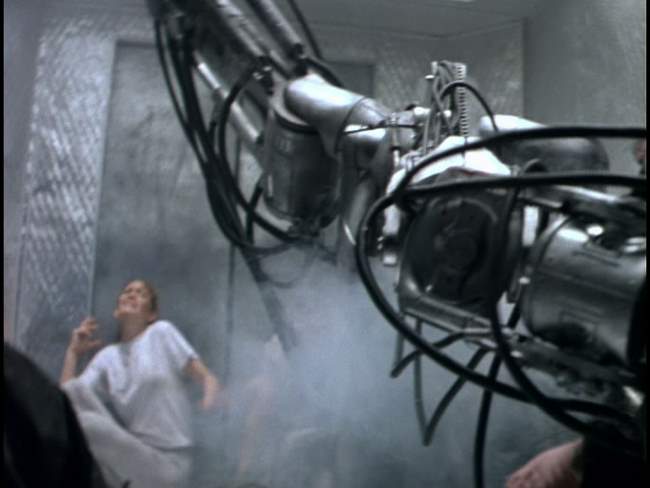
The Robot Monster: OK, so we have this really tough robot thing – virtually indestructible. Anyone wanna tell me why this robot has like a hundred rubber tubs hanging out, and nobody who fights it in hand-to-hand combat thinks of grabbing them? More to the point, why don’t the thousands of rounds of bullets affect the tubes? Bottom line, this robot was more silly than scary. In Hardware, the robot was continually shown moving quickly in low-light situations. This allowed Stanley to get away with a low-tech, but very believable robot. Unfortunately, Death Machine doesn’t take this approach – it shows the robot in detail to make sure you see its faults. Color me not impressed.
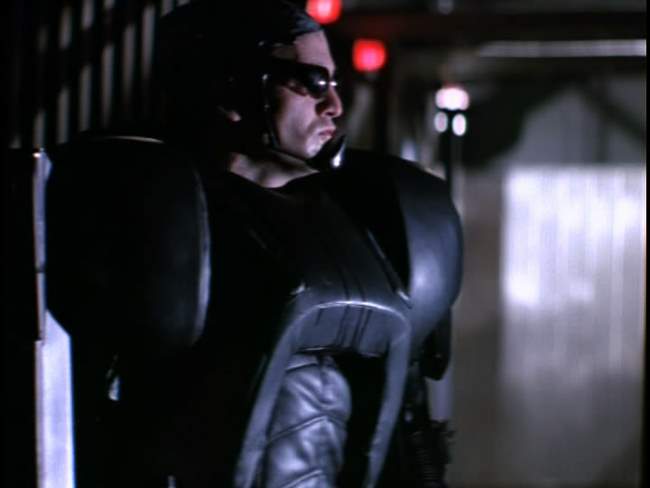
Yes, ladies and gentlemen, you can tell this is a cyborg because he’s wearing sunglasses. Also, he has that really big vinyl and plastic whatever-the-fuck-it-is on - DEFINITELY a sure sign of a cyborg warrior!
Death Machine’s Approach to Cyborgs: In Death Machine, the Chaank Armaments Corporation creates cyborgs by wiping someone’s memory and uploading it with detailed weapon systems training, and simple goals (e.g., protect me, seek out and kill “guy X”). In short, its approach to cyborgs assumes the human mind is synonymous with a hard disk. They even have an instance where a key character’s personality “backed-up” and then wiped from his mind to allow the “warrior personality” to be installed, and then later, they reload the initial personality. Puleeze, Norrington! I’m sure you coulda come up with a marginally believable cyborg warrior rationale. Too bad you didn’t take the time to think of one.
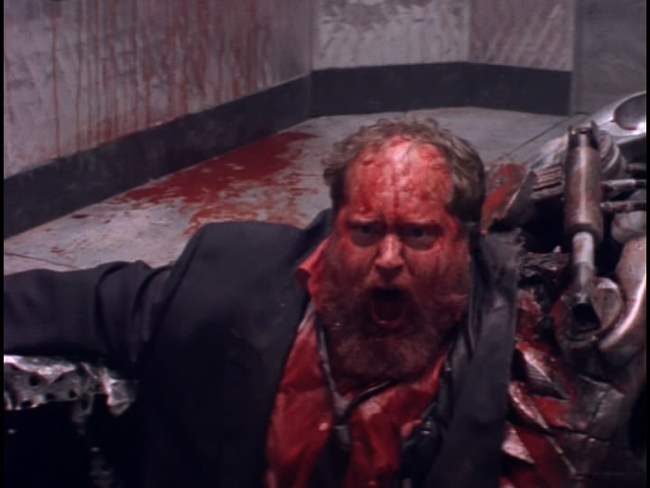
The Bottom Line: Truly, to even have a chance of being watchable, Death Machine would have needed to incorporate a heavy dose of T&A. While Ely Pouget has the looks, this never materializes. This is all the more annoying in that the inclusion of the porn reference flat out portends juicy T&A. Instead, we’re left with a shlock “B” movie, absent of T&A, without the effects, acting, plot or monster to carry the day. Brad Dourif’s character, while mildly amusing is just too over-the-top to stomach, and nobody else other than Pouget even stands out. Even worse, they screw up what should have been a very simple ending (this may be the only original part of the movie - in retrospect, Norrington should have copied this as well), leaving us with a almost complete let down, and no payoff for sticking around for 2 hours. In short, I don’t see much to recommend here.
~See movies similar to this one~
Movie Review By: SFAM
Year: 1997
Directed by: Jean-Pierre Jeunet
Written by: Joss Whedon
IMDB Reference
Degree of Cyberpunk Visuals: Medium
Correlation to Cyberpunk Themes: Medium
Key Cast Members:
Ellen Ripley: Sigourney Weaver
Annalee Call: Winona Ryder
Dr. Jonathan Gediman: Brad Dourif
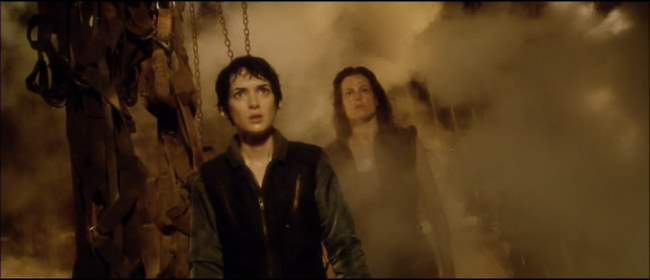
Overview: While Alien 1 and 2 were both stellar movies, the later two sequels definite suffer in comparison. Still, Alien Resurrection provides a significantly different Ripley than is encountered in the first three movies. Ripley is a clone, and an altered one at that. In fact she’s a merging of both the alien and human. With a significantly different approach to visuals and storytelling, Alien Resurrection may not equal the quality of the first two, but certainly can be considered original, which is sometimes a feat in itself for a sequel. The cyberpunk elements, while present, are still sedated, similar to the first Alien (I don’t really consider Alien 2 or 3 to have enough to consider them cyberpunk).
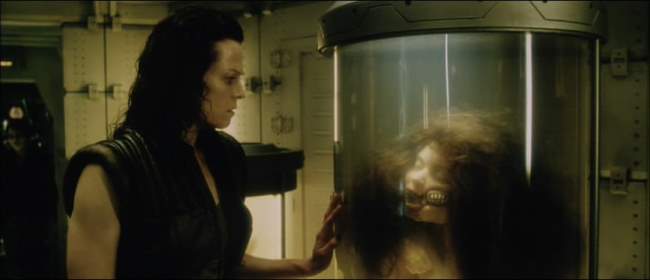
The Story: Two hundred years after her death, Ripley (Sigourney Weaver) has been cloned for the purpose of giving birth to the Alien Queen inside of her at the end of Alien 3. It’s not the corporation this time, instead it’s the good ‘ole government. While it’s never really fully explained how the melding of the two came about, you basically have to “roll” with it if you want to enjoy the movie. In any event, Ripley somehow survives the birth of the Alien, and is kept alive for “study” purposes.
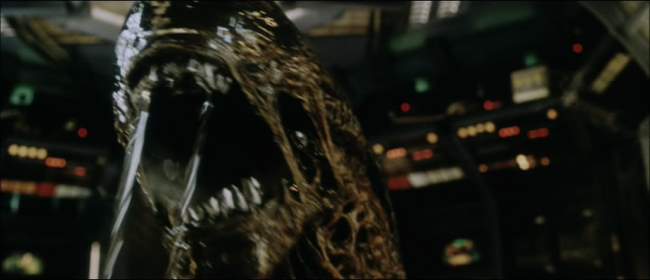
Meanwhile, the Alien Queen that Ripley births requires hosts for her eggs. Enter a group of mercenaries led by Elgyn (Michael Wincott). His group also includes Winona Ryder, Dominique Pinon, Ron Perlman, Gary Dourdan, and Kim Flowers. The mercenaries have captured a ship full of people in suspended animation, and have brought the victims to the military research ship for money and other goodies (including a few days sleep in a regular bed). Things go bad when fanatatical crazed head scientist, Dr. Jonathan Gediman (Brad Dourif) makes the mistake of leaving three of the Alien births in the same cage. Two of the aliens kill the third, who’s acidic innards then create a hole in the floor, thus forming a jail break. From there, its on – aliens are in control and have a field day in eating up the poor humans who can’t escape on time. But unfortunately for the Queen, her DNA has been melded with Ripley’s and her second generation offspring has turned out differently than intended.
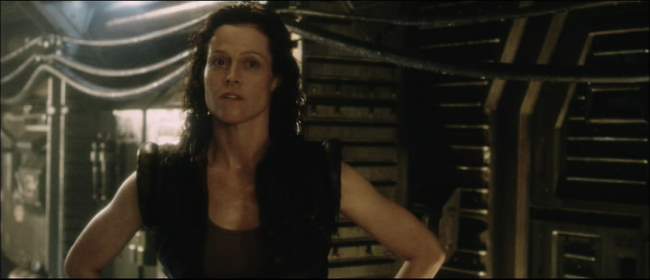
Ripley is Different in Resurrection: In Resurrection, we don’t get the tired, beaten down Ripley from the previous two movies who somehow manages to persevere and survive. Instead, Weaver takes to her genetic change with a gusto that mixes just the right mix of alien swagger, camp, and tender humanity. Most importantly, Weaver doesn’t take herself too seriously here. Ripley’s smirks more than anything else make the impossible set-up bearable. Its almost as if she’s saying, “Yeah, this is Frankenstein 4, but you knew the monster (me) needed to come back from the dead if there was to be a sequel, right? Just roll with it and we’ll be OK.” In short, Weaver almost single-handedly makes this sequel work. Ripley’s one liners (such as, “Who do I have to fuck to get off this ship?”) sometimes even come close to equaling those in Aliens. However, this approach can only go so far - if they ever plan on doing an Alien 5, they’re gonna need to revive Abbot and Costello!
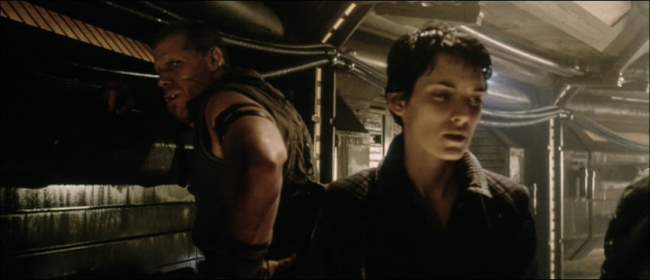
The Rest of the Cast: While Weaver shines, the same cannot be said of the rest of the cast. Some of the member are really hit or miss, while others fail altogether. Winona Ryder’s role was a bit too much for her to pull off. First she had to be a believable mechanic (Kaylee, she’s not!), and then had to be an undercover resistance member and finally had to work as a {SPOILER – highlight to read} second generation android. I don’t know who could have worked all three of these aspects into a coherent whole, but Ryder was not able to pull it off. Although, Ryder does shine in some of the scenes – especially those that are similar to Ripley’s role in the first movie where the Ryder is struggling to maintain sanity when everything is stacked against them. For other examples, Brad Dourif as the crazed scientist is too over the top, and Dan Hadaya as the military commander comes off as a complete imbecile. Two notable standouts are mercenaries Ron Perlman and David St. James – both turn in very solid and interesting performances.
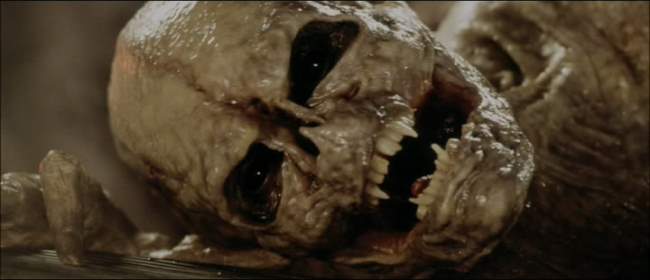
The DNA Mixing: OK, the DNA mixing explanation is just too hokey to work. Joss Whedon deserves some credit for at least not running away from this impossible task – instead he makes it a centerpiece to the story (but it still doesn’t’ work – then again, I don’t think anything would). Basically they needed a way of both recreating Ripley will still keeping her memories intact. Their work-around is to state that Ripley’s and the Alien’s DNAs melded together (I suppose this happened in the lava? Good thing they were able to retrieve it, ey?). OK, fine, but I have a few questions: Aliens are uniquely different from humans but their DNA is so close that its not distinguishable form one another? Or assuming the DNA was melded, how exactly did they know what they were looking at? More to the point, how did they figure out (even with lots of trial and error) to make two completely separate organisms out of the DNA? But even taking the ocean of salt needed to buy that explanation, how is it that an alien organism who grows by eating the material in the lungs is able to read Ripley’s memories and retain them? Again, while this clearly is problematic, you really just have to roll with it if you want to enjoy Resurrection.
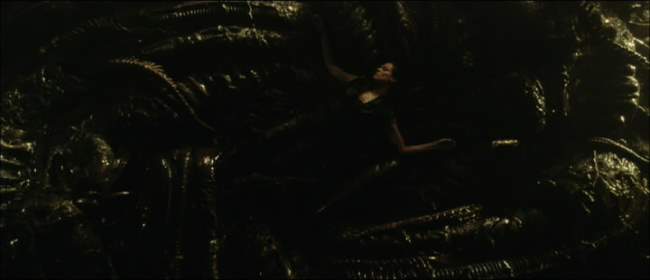
Genetic Manipulation Scare: Probably the scariest aspect of Alien Resurrection is the notion that in the semi-near future, genetics will be advanced enough and so well understood that even your basic crackpot scientists with the right equipment can play Josef Mengele in experimenting with mixing lifeforms to their hearts content. One can imagine a number of variations to this, but the jist of the concern is that its not too far a stretch to imagine that in the near future, less savory governments or corporations may be lured to do various genetic trials of this kind in the pursuit of fame and profit. This concept in Resurrection is as cyberpunk as one can get.
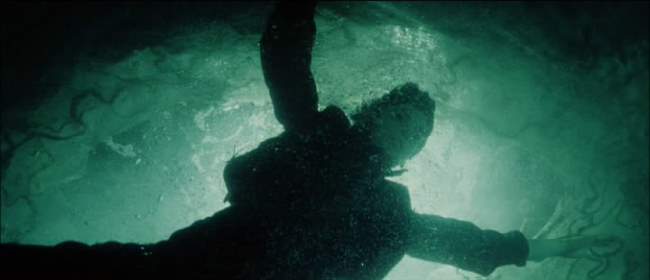
The Android: Unfortunately the back story is glossed over, but in Alien Resurrection, the androids have somehow developed a second generation android, one who is not beholden to human command. Not surprisingly humanity targeted them for termination, which caused the remaining second generation androids to burn out their communications devices and go into hiding. In Alien Resurrection, it’s the android who holds the tenets of humanity most dear. The android is more concerned with the fate of mankind than all the shallow and flawed humans in this movie. The android is even religious. One wishes this aspect of the androids was explored. If they truly feel that they indeed have a purpose for existence, how is this rationalized, and how have they changed the concept of a human deity to accommodate their self-worth?
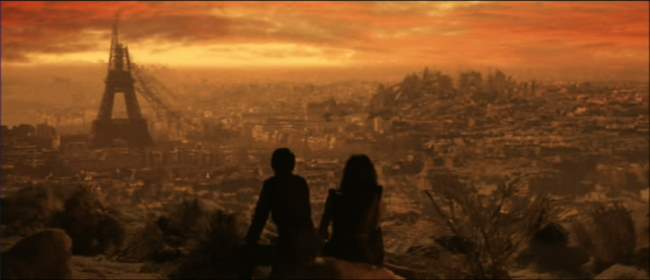
The Visuals: Director Jeunet and visual effects supervisor Pitof deserve credit for creating some wonderful visuals in Alien Resurrection. Resurrection contintually treats us to some wonderfully composed shots – shots that far exceed the qualities of the acting. Even if the plot and acting turn you off, the cinematography, wonderful set pieces, models and creature FX will help keep Alien Resurrection bearable. Like many cyberpunk films, a single color dominates the film – yellow in this case. Yes there are some blacks, but yellow seems to permeate all the key scenes.
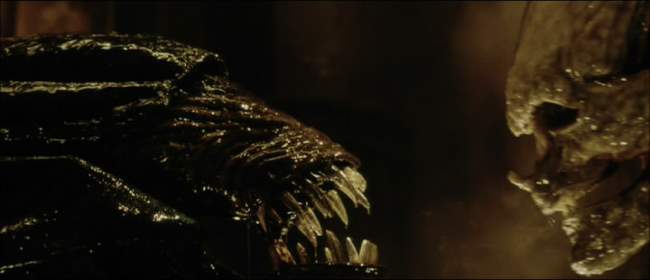
The Bottom Line: Yes, Alien Resurrection has an extremely problematic story within a flawed movie, but it ends up being more fun than it probably deserves. Even though the rest of the cast doesn’t always support her, Sigourney Weaver turns in a terrific performance. This, along with the originality, the wonderful cinematography and FX make Alien Resurrections a step up from Alien 3, and worthy enough to watch. While the cyberpunk elements are subdued, the android along with the genetics and dystopic civilization (destroyed by human wastes and technology) are enough to include it in this site. Alien Resurrection won’t flip your world like the first two did, but its still worth a watch.
~See movies similar to this one~
Movie Review By: SFAM
Year: 1997
Directed by: Takashi Miike
Written by: Itaru Era (screenplay), Hiroki Yamaguchi (story)
IMDB Reference
Degree of Cyberpunk Visuals: Medium
Correlation to Cyberpunk Themes: Low
Key Cast Members:
Kensuke Hagane: Tsuyoshi Ujiki
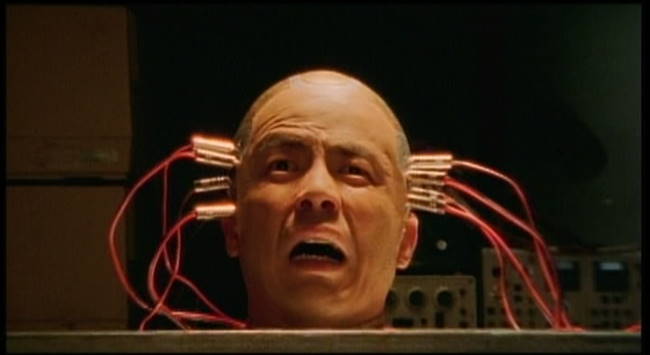
Overview: Full Metal Yakuza is simultaneously a campy low-budget Robocop Rip-off done with gangsters and an exercise in a mild form of extreme Japanese cinema. Director Takeshi Mike (best known for Ichi the Killer, but also did Andoromedia) does his trademark extreme blood spatters, and includes lots of head chopping, gun fighting, and a torture-rape-suicide scene thrown in for good measure. You won’t get any big picture thoughts out of this flick, but you might want to tune in for the crazy action and visuals.

The Story: Kensuke Hagane (Tsuyoshi Ujiki) is a slacker junior gangster who doesn’t show a lot of potential. In his mind, he wants to be a Yakuza – a tough guy with a code that’s feared by all. Unfortunately, he just doesn’t have what it takes. He sucks at fighting, enforcement, and worse – he even sucks at love making. He idolizes the older Tousa, a gangster tough guy extraordinaire that has a detailed dragon tattooed on his back. After Tousa gets taken prisoner for 7 years, Hagane perseveres to become an enforcer. Unfortunately, when released, the Yakuza gang betrays Tousa and shoots him down – Kensuke gets killed in the crossfire.
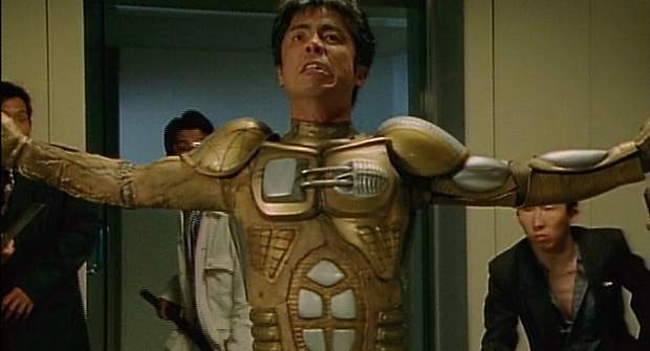
Then the weirdness begins – Hagane wakes up in a strange lab, and finds out that his head has been removed from his body and is now attached to a cyborg body, partially made up with Tousa’s remains. He has Tousa’s heart, hands, feet, tattooed back, and most importantly, his very large “member.” An insane genius scientist ((TETSUO’s Tomorowo Taguchi), for reasons never explained, has brought him back to life, but before Hagane agrees to work with the scientist, he must take revenge on those who killed him and Tousa.

Hagane goes all out, killing his way to the top, but eventually stops due to the pleading of his former friend. Along the way, he also finds Tousa’s mistress (Shoko Nakahara), and falls in love with her. Things go horribly wrong when she is taken prisoner. Hagane now has to finish what he started.
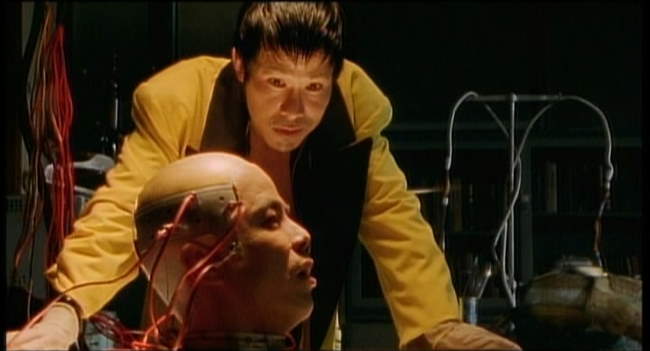
Yes, He’s a Cyborg, But…: Nothing in this movie should be taken too seriously, especially the cyborg aspects of this. Kensuke eats bullets and other assorted metals for energy, but apparently doesn’t even need to grind his teeth to chew them. His body is fully metal, but apparently he’s had an extra large dick grafted on as well. He does weird chants in order to temporarily turn off his emotions (apparently, this trips a jump switch of some kind). I could go on, but nothing in this depiction of cyborgs is intended to be anything other than the creation of a setting.
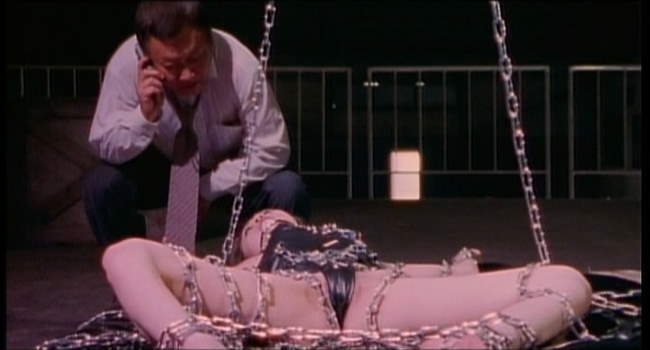
The Visuals: Full Metal Yakuza gives us a number of trademark Takeshi Mike shots, including massive screaming, gratuitous blood spurts shooting in all directions, torture and rape, and a variety of surreal action scenes. From a cyberpunk standpoint, the interesting visuals take place when Hagane is first transformed into a cyborg. In many ways, they resemble a lighter version of Android from Notre Dame’s visuals.
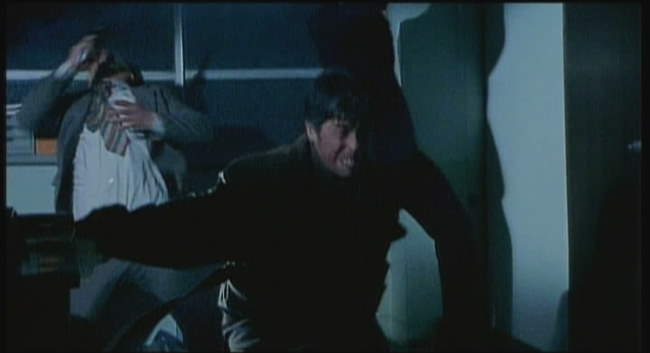
The Bottom Line: Full Metal Yakuza is interesting in that it was apparently made for a very low budget. There is enough here in terms of strange, extreme cyberpunk visuals that many might really enjoy this flick. Just don’t be expecting too much from the story. There are whole sets of scenes that go absolutely no where (the female cyborg chick, for instance), and many more that strain the bounds of coherence. But if you’re interested in watching a campy, extreme Japanese, non-sensical cyberpunk flick, you might want to give Full Metal Yakuza a try.
~See movies similar to this one~
Movie Review By: SFAM
Year: 1993
Directed by: Fred Dekker
Written by: Frank Miller & Fred Dekker
IMDB Reference
Degree of Cyberpunk Visuals: Medium
Correlation to Cyberpunk Themes: Low
Key Cast Members:
RoboCop: Robert John Burke
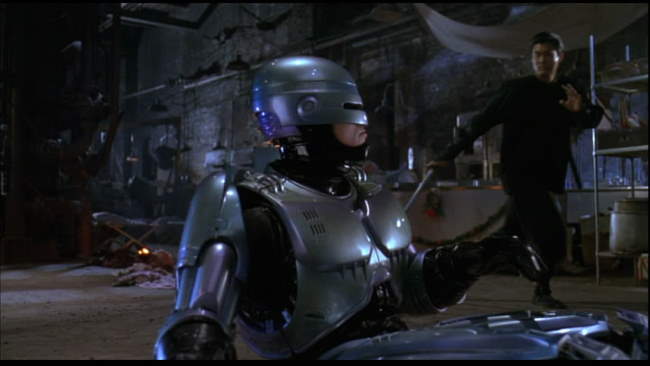
Overview: The first Robocop movie was an absolutely terrific, innovative flick. Robocop 2 really sucked, but not as bad as Robocop 3. All pretense of putting together a decent movie goes away in Robocop 3. Peter Weller, who plays Robocop in the first two movies wisely skipped this piece of shit. The only remaining cast members from the first are the Police Captain, Officer Lewis (Nancy Allen), the stooge corporate dude, Johnson (Felton Perry). Of these, only Officer Lewis had any chance of carrying a decent amount of heft for the show, but she is prematurely bumped off without reason, and the other two are pretty much just caricatures of themselves. In short, Robocop 3 is a pure, low-budget trashy sellout made for 8-14 year-olds who were familiar with the G-rated series - the plot goes for the young genius hacker kid and ninja bad guy vice attempting to work up a real plot.
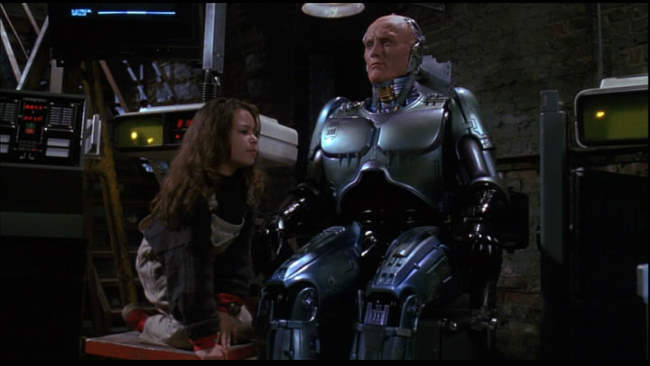
The Story: Like Robocop 2, OCP is still trying to create a massively expensive city in a place that only has the destitute poor. God knows why, as nobody will be able to afford ANYTHING created, but we’re just supposed to go with it. In this episode, we have the nasty Japanese buying up OCP and hiring a cheesy security firm to simply gather up all the poor people and ship them out to concentration camps. But Robocop doesn’t like this, and decides he no longer feels like obeying his prime directive that stops him from challenging OCP employees. Instead, he joins a ragtag resistance comprised of local yokels, the genius kid, and of course his sympathetic OCP scientist care taker. But wait! There’s more! The evil Japanese have sent a cyborg ninja to kill Robocop. Ohhhhhhh – you can just cut the tension with a plastic spoon!
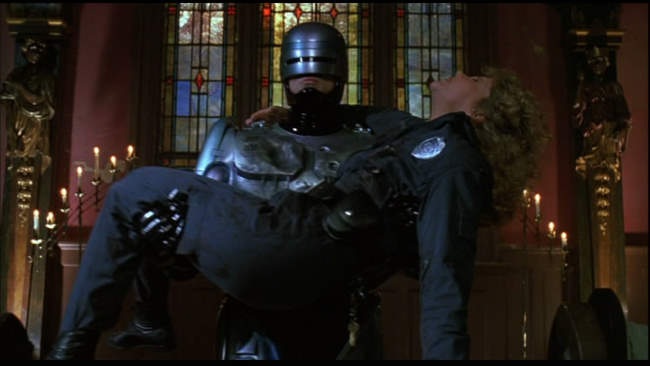
The Bottom Line: Honestly, I have a hard time seeing how Frank Miller is in any way responsible for the screenplay for this piece of trash. It’s pretty sad to see the Robocop movies end in such a trashy way. Yes, there is another kiddie miniseries that follows this, but truly, Robocop should have stopped after the first. This franchise is the poster child for Hollywood fuckups. In thinking about it, they could have done quite a lot with the Robocop universe, and potentially even could have done interesting things with the original Robocop character. Instead, they choose the cheesy derivative path. This led to both less money and the painful death of the cash cow.
~See movies similar to this one~
|









































































